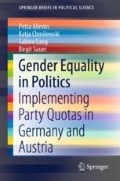Abstract
Germany and Austria celebrated 100 years of women’s suffrage in 2018 and 2019, respectively. The promise of parity that came with the active and passive right to vote, however, remains elusive. This chapter introduces the main themes of the book, focusing on descriptive political representation of women and asking if voluntary party quotas are sufficient to reach equal representation. As all quota parties in Germany and Austria support the goal of equal participation of women and men in elected and party office, quotas are presented as a means to exactly that end. In order to measure parties’ commitment to their stated goals, we introduce the post-quota gender gap and define it as the difference between a party’s adopted quota and the actual share of women in legislative bodies on the national and subnational level.
Access this chapter
Tax calculation will be finalised at checkout
Purchases are for personal use only
Notes
- 1.
A women quota sets goals for the share of women, while a gender quota defines a minimum share for each sex.
- 2.
To some extent, the qualifier ‘voluntary’ is misleading. Although the term voluntary party quotas is firmly established, it should be clear at the onset that such quotas are not ‘voluntary’ in an everyday sense; they are labeled ‘voluntary’ because they lack formal legislation and applicability to all parties. They do, however, pose a formal (self-induced) set of rules for the adopting party.
- 3.
Even though the former German Democratic Republic (GDR) did not have an official women’s quota in politics, the share of women in the national parliament, the Volkskammer, was always higher than in the German Bundestag. Already the first assembly had a share of 20% women and the percentage increased to 32.2% in 1986 (Pawlowski 2008). By comparison, the ‘critical mass’ of 30% was reached in unified Germany only in 1998 (Abels et al. 2018). As this study interrogates a subset of parties that started to implement voluntary party quotas in former West Germany, all following references to Germany in historical context refer to the Federal Republic of Germany (FRG).
- 4.
We are aware that the question of adequate political participation and representation also speaks to intersectional aspects. It is beyond the scope of this book, however, to address these aspects.
- 5.
Zielvereinbarungen (translation by authors). All following translations from original German text are from the authors.
- 6.
However, in 2019, the NEOS featured 50% women’s representatives and among ‘Jetzt—Liste Pilz’ three out of seven representatives were women.
- 7.
In fact, on the Land level, parties still sometimes even miss their electoral-list quota.
- 8.
The authors would like to thank the founders and members of the Gender Equality Policy in Practice (GEPP) project (https://www.csbppl.com/gepp/) for stimulating discussions about gender equality in political representation and, more specifically, quota implementation.
- 9.
Our case selection might be criticized for encompassing two West German Länders and not an Eastern Land. We submit that Berlin is in fact an East-West mixed Land and that, in order to analyze quota development over time, we needed a fit between two structurally similar cases from Germany and Austria with medium to low women’ representation. Baden-Württemberg is similar to Upper Austria in terms of political economy and conservative culture, and it is the German Land with the poorest descriptive representation in its Landtag.
- 10.
We exclude the community level in our analysis, because any case selection would become a random choice with the high number of municipalities in both countries. For studies on women’s descriptive representation on the community level please refer for Germany to Holtkamp et al. (2009), Kletzing and Lukoschat (2010), Lukoschat and Belchner (2014), Davidson-Schmich (2018), Kletzing (2018a, b); for Austria please refer to Steininger (2000b, 2019).
Author information
Authors and Affiliations
Corresponding author
Rights and permissions
Copyright information
© 2020 The Author(s), under exclusive license to Springer Nature Switzerland AG
About this chapter
Cite this chapter
Ahrens, P., Chmilewski, K., Lang, S., Sauer, B. (2020). Introducing the Cross-National Comparison of Quota Implementation. In: Gender Equality in Politics. SpringerBriefs in Political Science. Springer, Cham. https://doi.org/10.1007/978-3-030-34895-3_1
Download citation
DOI: https://doi.org/10.1007/978-3-030-34895-3_1
Published:
Publisher Name: Springer, Cham
Print ISBN: 978-3-030-34894-6
Online ISBN: 978-3-030-34895-3
eBook Packages: Political Science and International StudiesPolitical Science and International Studies (R0)

